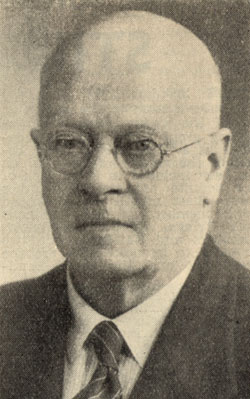
Council of Heads of Australasian Herbaria
Australian National Herbarium
Biographical Notes
 |
Council of Heads of Australasian Herbaria |
 Wilson, Herbert Ward (1877 - 1955)
Wilson, Herbert Ward (1877 - 1955)from Wild Life magazine, Nov. 1942, p. 430 (see full page PDF with cartoon)
"Major Wilson has retired from the post of Senior Lecturer and Lecturer in Nature Study in the Melbourne Teachers' College, and Lecturer In Method of Biological Science in the Melbourne University School of Education. With a break of four years from 1915 to 1919 he has held the Nature Study post at the Teachers' College continuously since 1908 - and thereby hangs a tale.
As a boy of six in 1877, he came from Yorkshire, England, with his family, and after a short stay In Adelaide his father took up land some miles out of Dimboola, which was then the terminus of the railway. During the early part of the family's pioneering work he ran more or less wild In the bush, and there gained a love and understanding of nature which has ever since been the guiding principle of his life. When the family moved close enough to Dimboola for him to attend school, he had to continue his real studies out of school hours, for natural history was not in the school curriculum in those days, nor were there any books of reference to help him. Though only a youngster, he was even then a pioneer. At the age of 15 he became a monitor ("pupil teacher not attached"), and two years later he entered the service of the Education Department. He was naturally Interested in the movement in 1900 to introduce nature study into the school curriculum. In 1905 the first schools' nature study exhibition was held in Geelong, and in 1906 Dr. J. A. Leach was appointed Organising Inspector for Nature Study. Wilson, at that tIme, was teaching at Raymond Island, and attending the Bairnsdale Technical School to study such science subjects as were a vailable there. The exhibit of Raymond Island school at the Bairnsdale nature study exhibition aroused wide interest, for it showed for the first time a study of nature applied to local activities - in this case the fishing industry of the inhabitants of the island.
The interest of the Director of Education (Mr Frank Tate) and of Dr. Leach was aroused immediately. Wilson was chosen to superintend the Bairnsdale Court at the great VictorIan State Schools' Exhibition in Melbourne later in the year, and that court practically "stole the show." It demonstrated that nature study was not merely a fad; that, properly organised, it had great practical value; and, as a result. nature study came to be more highly respected as a school subject. The next step was to select ten teachers from Victoria, two from South Australia, and two from Western Australia to take a special course of training in nature study under Dr. Leach. All except one had already had the advantage of a Teachers' College course - the one was Wilson, whose personal keenness gained him the selection. At the end of the course he headed the list, and in the following January he was appointed lecturer at the Teachers' College. From that time onward Wilson was Leach's right-hand man. He assisted in the compilation of the "Descriptive List of the Birds of Victoria," which was issued as a departmental circular of information. Three years later, with information added about non-Victorian birds, and profusely illustrated, the "Descriptive List" developed into the classic "Australian 'Bird Book," for which Wilson supervised the painting of the birds and assisted in preparing the half-tone blocks. It was he, too, who saw the book through the press
Outside his teaching work, Wilson became one of the mainsprings of the natural history societies. He became known as a leader in the Field Naturalists' Club of Victoria, and in the Microscopical Society. As honorary secretary of the Royal Australasian Ornithologists' Union he was responsible for the present organisation with a committee and a secretary in each State. But it was as organising secretary of the Bird Observers' Club that he made the most lasting impression - it was due to his energy and inspiration that the Gould League of Bird Lovers was founded, and that Bird Day was Introduced officially into the schools. One of his proudest possessions is a copy of Campbell's "Nests and Eggs of Australian Birds," presented by the B.O.C. and inscribed as a recognition of his work in founding the Gould League. Other States have now extended the Gould League until it is an Australian Institution, and not merely a Victorian one.
Much could be said of Wilson's war work; how he enlisted as a private in March, 1915, and served in the ranks; how his success in organising the gas training of some 33,000 men in 1916 earned him a Mention in Despatches; and how, from Chemical Adviser to the Australian Corps he was elevated to take the corresponding post for the Fifth Army, supervising gas work in the field in France, the firing of gas shell, investigating enemy gas attacks, and training some 500,000 men in gas warfare. For these services he received a further Mention In Despatches, at Buckingham Palace King George V. decorated him with the Military Cross, he was made an Officer of the Order of the British Empire. . . ."
Source: Extracted from: Wild Life magazine, Nov. 1942 p. 430
Portrait Photo: from: : Wild Life magazine, Nov. 1942 p. 430